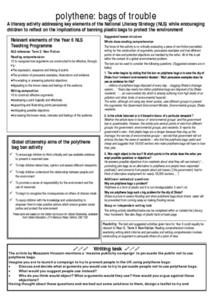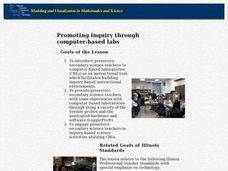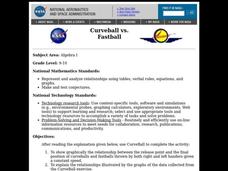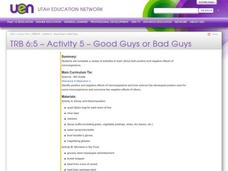Curated OER
Polythene: Bags Of Trouble
Students investigate the use of polythene bags in the community and measure the possible impact upon the environment. They conduct research using a variety of resources. The information is used in order to create an evaluative opintion...
Curated OER
Trees-whiz
Students discover the importance of trees to the environment. After seeing trees in nature, they sketch various examples and collect all of them to create a book. In a journal, they develop questions they would want to ask a tree if it...
Curated OER
What is Groundwater Pollution Doing to the Neighborhood?
High schoolers explore the impact of groundwater pollution on health. They examine the carcinogenic contaminants and their possible sources. Students develop methods to lessen or eliminate the pollutants from the environment.
Curated OER
Plants and Air Purity
Learners explore how green plants help improve air quality. They read an article and discuss the importance of air quality and its effects on the human body. They investigate by connecting hose to the top of a Bell jar and to a funnel....
Curated OER
Promoting Inquiry Throught Computer-Based Labs
Student Teachers are given the opportunity to examine how to use a computer-based laboratory for inquiry. The practice is done to teach future teachers how to use these tools so they can be ready for use in the classroom environment.
Curated OER
Animal Track Mural
Students create a mural depicting who they are. They observe and describe animals in their local environment and relate themselves to an animal. They also discuss how animals show proof of them being in a certain area.
Curated OER
Fuel Cells
Young scholars examine how fuel cells and combustion engines work. Using the internet, they research the positives and negatives of the various energy sources. In groups, they complete an experiment with a working fuel cell model and...
Curated OER
Oak Ridges Moraine: Southern Ontario's Sponge
Students examine the characteristics of the Oak Ridge Moraine in Canada. Using a map, the locate the moraine and present and defend a position on how the resources found there should be used. They must use proper geography terminology...
Curated OER
Tree Cookie Combat
Fourth graders discover what trees need to live and grow in the environment. They realize that trees sometimes interact or compete with other organisms as well as each other. They identify the physical characteristics of Utah's...
Curated OER
Technology: Programming Graphics
Students use the DrScheme program to create graphics for clip art. Using graphics, they plan their designs using basic shapes, plotting its positions, and studying the relationships between points. By plotting the necessary data on...
Curated OER
Extracting Meaning From What We See
Students recognize that all cultures have the same needs that they try to satisfy in ways that their predecessors found effective in their particular environments. Students discover how and why cultures change their customs.
Curated OER
Curveball vs. Fastball
Students graph the relationship between the release point and the final position of curveballs and fastballs thrown by both right and left handers given a constant speed, and explain the relationships illustrated by the graphs of data.
Curated OER
Schools for Sale
Pupils differentiate between public and private goods. They analyze and evaluate various and positions on a public issue. They establish decision-making criteria. They develop a public policy based on a formal decision making model.
Curated OER
Where Can I See The Sea?
Learners see how the pieces of the fossil puzzle fit together to allow the paleontologist to imagine the earth as it was millions of years ago. They draw a map showing what environments were present in a certain area more than 70 million...
Curated OER
Nobody's Home
Learners participate in a simulation activity that examines the economic impact of the construction of a reservoir-both the positive and negative side.
Curated OER
Understanding Our Planet's Food Web
Sixth graders, in groups, examine how humans have a tenuous position as part of an ecosystem.
Curated OER
Good Guys or Bad Guys
Sixth graders complete a variety of activities to explore both positive and negative effects of microorganisms. They, in groups, engage in a series of experiments which illustrate the effects of certain molds.
Curated OER
Consumer Choices
Students identify and discuss the issue of sustainable fishing. Students research a seafood product available in their community. Students assess and defend a position about whether a seafood product for sale in their community is...
Curated OER
Environmental Issues in South Carolina
Students research governmental agencies that deal with the environment and chart aspects about each agency. They role-play a city council meeting to address the topic of building a waste to energy facility.
Curated OER
Environmental Assessment Course
Students explore how the campus is linked with the larger environment. They investigate how to collect data by interviewing and researching, analyze findings, and make recommendations. Students explore how to present their findings to...
Curated OER
The Language of Mathematics
Students integrate the language, concepts and skills of math into the daily routine and classroom environment. They think mathematically by participating in short, daily, individual, small group, whole group and transitional activities...
Curated OER
Feedback and Flowcharts
Sixth graders explain what a negative feedback system is and they distinguish it from a positive feedback system. They describe examples of how negative feedback is used in both nature and technology. , Students define homeostasis, and...
Curated OER
Coastal Quandary
Students explore the debate among development and environment experts on evacuation coastal areas and take part in their own debate on "evacuation versus redevelopment".
Curated OER
Power and Portraiture
Ninth graders compare and contrast the art works of Van Eyck and Daumier. They examine pictures of upper and middle class people and identify the artifacts/environments particular to each group.

























